Introduction
After the fall of the Soviet Union in the early 90’s, Ukraine was left with thousands of T-80 tank platforms in the city of Kharkov. This gave them the ability to produce hundreds of modernized main battle tanks, but also left them with hulks of tanks that relied on equipment from the Russian Federation. Ukrainian tank designer KMDB sought to solve this problem by creating a new, all-Ukrainian vehicle derived from the T-80 design. Thankfully for them, the Soviet T-80UD could act as a gap between the original T-80U and the new Ukrainian design, designated the T-84.As defined by chatgpt:
The T-84 is a Ukrainian main battle tank that was first introduced in the late 1990s. It is an advanced version of the Soviet T-80 tank, incorporating various improvements and modernization features:
-Design and Features: The T-84 features a low-profile turret and composite armor, providing enhanced protection against conventional threats. It has a crew of three, including a commander, a gunner, and a driver. The tank is equipped with advanced fire control systems and a powerful 125mm smoothbore gun, capable of firing various types of ammunition, including APFSDS (Armor-Piercing Fin-Stabilized Discarding Sabot) rounds and guided missiles.
-Mobility: The T-84 is powered by a 1,200 horsepower engine, allowing it to achieve speeds of up to 70 km/h (43 mph) on roads and approximately 45 km/h (28 mph) off-road. The tank also features advanced suspension and tracks, which contribute to its high mobility and maneuverability.
-Active Protection System: The T-84 can be equipped with an active protection system (APS) called "Zaslon," which provides enhanced protection against incoming threats such as anti-tank guided missiles (ATGMs). The APS utilizes radar and electro-optical sensors to detect and intercept incoming projectiles.
-Export and Variants: The T-84 has been exported to several countries, including Pakistan, where it is known as the Al-Khalid tank. Ukraine has also developed various variants and upgrades of the T-84, such as the T-84-120 "Yatagan," which features a more powerful 120mm gun, and the Oplot-M, an improved version with enhanced armor protection and modernized systems.
-Service in the Ukrainian Armed Forces: The T-84 is actively used by the Ukrainian Armed Forces. It has been deployed in various conflicts and military operations, including the ongoing conflict in eastern Ukraine.
Development
About Morozov, behind the T-84
In 2010, the Kharkiv Design Bureau for Mechanical Engineering A. A. Morozov (KMDB) celebrated its 83rd anniversary. This organization was funded in 1927 when a small group of designers assembled at the Kharkov Locomotive Plant was tasked to develop the T-12 tank. Later, under the guidance of chief designers M. I. Koshkin and A. A. Morozov, the T-34 and T-64 were created, making Ukraine thanks to KMDB a solidly implanted and renowned member of the world's "tank club" counting less than 11 countries able to design and built design modern tanks. In the last decades of the USSR, development and production of tanks shifted around Leningrad, Omsk, Nizhny Tagil, but Kharkov was still part of the move. The three "main" Soviet tanks were produced between them, the T-80, T-72 and T-64, which shared little with each other.Object 478
The idea behind producing diesel powered T-80’s was nothing new, and the Object 478 was the original vehicle to try doing this, all the way back in the late 1970’s. It was based on the Object 219, but equipped with an all-new 6TD-1 1,000 hp diesel engine, and in every other way was identical to the regular T-80 variants.Object 478B
As a further development of the Object 478, the 478B used the improved chassis and turret of the T-80U in combination with the 6TD-1 engine. It was this model that went into mass-production, and it was designated the ‘T-80UD’, which showed it was a diesel modification of the T-80U. In the late-90’s, it was given a welded turret for export to Pakistan (see later).From the T-80UD to the T-84
The last was launched into mass production by a decree of September 2, 1985, derived from object 478B. The T-80UD developed by KMDB had such a large number of innovations compared to the T-80 as originally even planned that it was going to be called the T-84, but a fourth main battle tank in service was apparently already considered indecent. Instead of a complex and hungry gas turbine, the new Ukrainian tank was to be powered by a compact two-stroke 6TD diesel engine of similar power at nearly 100 hp (1000 hp) to the T-80.The new turret designed by KMDB, worked out from object 476 was also completely reworked for the ergonomics and protection standpoints, and only the drivetrain remained unchanged. The new T80UD was equipped with the most modern equipment at that time between the 1A45 Irtysh automated fire control system (ACS), the 9K119 Reflex guided weapon system (KUV), TPN-4 Buran PA night infrared sight, and 1G46 laser rangefinder sight "Irtysh". The T-80UD started to enter elite divisions such as the Taman motorized rifle and Kantemirovskaya tank divisions and paraded twice on the Red Square in 1990, the last military parades held in USSR. So in the end, the T-80UD was never officially adopted by the Soviet Army, with a final decision made early in 1992, signed by the Army CiC of the Federation. Thus, Ukraine now independent was free to pursue its own project, based on the T-80UD which quickly became the T-84.
A new start: Post-USSR Tank development at KMDB
The collapse of the USSR buried extensive production plans concerning the T-80UD at Kharkov. Malyshev until 1992 still managed to build 300 of these, and the oldest tank design bureau and plant fell under the responsability of a new sovereign state, Ukraine. Its newly formed Armed Forces did not have the funds however to purchase new equipment and still had its own elderly park of some 6,128 tanks and 6,703 armored fighting vehicles. After ratifiong the Treaty on Conventional Armed Forces in Europe (July 17, 1992) Ukraine had to reduce this park to 1,974 tanks and 1,945 armored vehicles in three years. By 2010 it was planned to have no more than 2000 tanks.As a result, KMDB found itself in an extremely difficult situation, with at their disposal a good tank with already well-established production, but no customer ready to pay and maintain it. KMBD, one of the largest tank-building enterprise in the world, state-owned, entered a brand new phae of existence, and started to prepare for privatization, during which it would be pulled apart piece by piece. The design bureau for mechanical engineering and the design bureau for engine design, former KKBD both became independent. In the end to keep everything afloat the olnly solution was to turn towards the global arms market.
Fortunately for the plant and high-ranking Ukrainian officials the arms trade was seen as an extremely profitable business, a powerful cash-machine at their disposal which was the only solution to maintain the activity of plant, through notably upgrade packages, and selling upgraded tanks in the park that was going to be cut down. In 1992, a decree of the Cabinet of Ministers of Ukraine planned the full restoration of tank production at the plant now named "Malyshev" and in June the head of KMDB, M. D. Borisyuk became general designer. In 1993, another decree (No. 181-3 of 03/12/93) was ordering the development of an improved T-84 tank (codename "Kern"), with the production of its components and systems developed in the most closed cycle in Ukraine to avoid any leaks. Indeed in the 1980s, components supplies to Kharkov came from other Soviet republics up to 60% like the turret made in Mariupol, the cannon in the Urals, track system in Tikhvin notably.
Looking for Customers: Pakistan
The search for a potential foreign buyer, the marketing and communication branch soon found one: Pakistan, which showed interest in the purchase of a modern tank. Although its long-term cooperation with China was now a sure fact, coupled with a buregoing domestic tank industry, still at that stage, the development and production of a modern tank was still out of reach. The latest endeavours of the country has been indeed upgrades of the T-54/55 and assembly of a variant of the Type 85.According to memoirs of G. I. Levchenko, director of the plant, the search for access to the foreign market started under Gorbachev's perestroika already and a trade company with an agressive export organization was established already in Kharkov, but it was gradually starved for funds. After the collapse of the Union, framed by the legal field of the Ukrainian state, it was completely refunded and rejuvenated. Past export prospects for Pakistan were rebuilt, tanks to a large part to the Soviet era surviving business contacts. There was also goodwill from Pakistan, which in a tense Indo-Pakistani relations (the former well supplied by Russia). In the end, what happed is that the implementation of the Ukrainian-Pakistani tank contract for 320 T-80UD tanks by February 15, 2001 pushed India to purchase 310 T-90S tanks from Russia (the export version of the T-90).
In 1993, the desire of the Pakistani military materialized in an invitation to Ukrainian specialists along with armored vehicles for initial tests. Three months were allotted but thanks to a clear organization and working seven days a week, these were done in one and a half week. On August 2, a group of 13 KMDB workers led by Designer M. D. Borisyuk and General A. S. Medvid along with two tanks arrived at Lahore, for gruelling tests in the Thar Desert. The Pakistanis were especially interested in the possibility of operating the T-80UD in desert conditions, through dust storms and under +55°C. The two vehicles were a bit different from one another albeit similarly called 478DU, just N°1 and 2. Their chassis had metal rollers and internal shock absorbers from the T-64 type for one while the second kept the original T-80UD undercarriage with rubberized tires rollers. It was assumed under severe dust, intense abrasive wear of the rubber tires would occur. So the T-64 rollers which rubber cushioning was inside the metal (steel rim in contact) seemed preferable. This enabled also a weight gain of almost 2 tons and saved scarce rubber (formerly imported from Sverdlovskd). However the Pakistanis preferred the less noisy rubber solution, which was also better at absorbing vibration. In the Thar Desert, both made 2,000 km through the dunes. The Chinese T-85 also was in trials on a completely different area, which allowed the Pakistanis to pursue unofficial comparative tests...
Design of the T-84: T-80UD upgrades
Continuing to fine-tune and improve on the T-80UD to be sure of its export potential, KMDB started work on its local evolution, the T-84. Since upgrades were to lead to an increase in weight, designers wanted to preserve mobility, requiring either a new powerplant of an evolution of the 6TD.The new 6TD2 engine
Kharkiv designers however already had a private venture development to start with, the 6TD-2 which was rated for 1200 hp as tested at KhKBD under N. K. Ryazantsev. The chief designer increasing the compression from 3.35 to 4.4, making an extra 200 hp by installing a new two-stage axial-centrifugal compressor with greater efficiency, instead of the single-stage compressor of the 6TD. Temperature of the exhaust gases and turbine rotation increased, and so many parts had to be redesigned, based on works by the Kiev Institute of Welding E. O. Paton which worked on a new automatic blade welding technique fit for a new heat-resistant material, and increase adaptability to spare fuel with the better efficiency around 2600-2800 rpm.The new and still light and compact 6TD-2 engine achieved 73.8 hp/l at 0.98 kg/hp, surpassing for example the French turbodiesel V-8X 1500 of the French Leclerc tank. Strictly speaking howver the latter mixed an internal combustion engine and gas turbine, whereas the Ukrainian engine was a compact single entity. The more traditional German MTU 883-1500 of the Leopard-2 had a lower liter capacity of 54.7 hp/l at 1.2 kg/hp. The Ukrainian engine in any case eclipsed completely the Russian V-92S2A of the T-90S tank rated for 25.7 hp/l. So for less space, the T-84 engine offered three times more efficiency.
First experimental tests of the 6TD-2 back in 1979 enabled production readiness. For this, was created at KhKBD the special test complex "181N" to conduct research and tests under special conditions (+50°C temp, undrr dusty winds, or with rarefaction of air corresponding to an altitude of 3000 m and under freezing winds down to -50°C and below. While gaining these 200 hp, the 6TD-2 engine still shared 90.12% parts and components with the 6TD, nothing short of an accomplishment. Thanks to this still compactness, the installation of a more powerful diesel engine in the existing engine compartment of the T-80 UD caused no special problems. But it still required a radical increase in the efficiency of the cooling system: It was necessary to modify the air intake, modifying the outlet diameter of the nozzle and introduce a seventh cooling row in the radiators. By 1992, after successful testing of a chassis fitted vehicle with the new engine and modified cooling system, the commission reviewed and approved the design for serial production, named as "T-84 tank with 6TD-2 engine (1200 hp)".
A new Turret
Also in 1992, a prototype of a new welded-rolled homogeneous steel turret was manufactured and successfully tested. The "wire rod" turret system was developed by KMDB back in 1984-86 to create a unified fighting compartment. The new turret had clear advantages like improved armor protection, increased survivability, more technologically advanced and yet cheaper to manufacture. This was quite a leap from the cast turret industry in the USSR, and so the ministry at the time (before the fall of the USSR) was in no hurry to replace existing ones for the new welded turrets.The situation was unlocked with the fall of USSR. Malyshev Plant received from the new government and direction the go-ahead to get rid of cast turret (manufatured before in USSR) and also the armored hull parts made in Mariupol's Azovmash, just liquidated and not to be restored. The final nail in the coffin for cast turret came when a purchase attempt in Russia failed as the supplier's cost was raised so much that negotiations ended. It was necessary to establish serial production in Kharkov, in the brand new facility dedicated to turret manufacture, named N°150. Armored steel was provided from Azovmash and final assembly of the turrets was carried out in Kharkov.
A new Tank Gun
In accordance with the decree officializing the T-84 tank, work started on a new Ukrainian tank gun. Previously concentrated in Perm, Motovilikha Plant, they were previously imported to Kharkov. All links were severed post-1991 and so, Ukrain was stuck with its existing stocks. In 1993, the State Scientific and Technical Center for Artillery and Small Arms under Designer L.I. Bondarenko at Kiev began development of the KBAZ gun, close equivalent of the Soviet 2A46M-1 gun. By 1996, a prototype was completed and started preliminary tests. However, serial production was not possible as the plant lacked equipment and tooling for it. Therefore it was decided that the guns would be assembled at Malyshev, with the cradle mounts coming from JSC "SMNPO" at M. V. Frunze, the barrels supplied by the Zaporozhye Dneprospetsstal, under the design support and supervision by KMDB. Frunze plant already produced heavy piping for the oil and gas industry and indeed had all the necessary to manufacture barrels after installing some additional equipment. The production of the first Ukrainian 125-mm tank gun was ready to start by March 1998. Meanwhile, the design team worked on improving with it the old T-55 and T-72, whereas they created a variant compatible with NATO 120 mm ammunition in order to facilitate export.Public reveal at Idex 95
By the spring of 1995, a complete experimental T-84 tank was demonstrated by KMDB, with personal from the new Ukrspetsexport (military export state company) at IDEX-95 in Abu Dhabi, United Arab Emirates. This prototype had the number 478DU2, and in addition to the new engine, welded-rolled turret, had a TShU-1 "Shtora-1" optoelectronic countermeasure system. The turret was improved at the time and had a fully stamped roof made of high-quality armor steel using electroslag remelting, increased strength and survivability. It had a simpler form more convenient to arrange multi-layer armor and ERA bricks. Compared to the old cast models, the internal volume was also increased, leaving a bit more room for the crew and allowing better ergonomics. Both were a gift end for export modifications, enabling opportunities for further improvement as well.The prototype also showed the built-in Kontact 5 dynamic protection which comprised the TShU-1 Shtora-1 for active protection, (optoelectronic countermeasure) detecting a laser beam and warning the crew about a laser hit while creating infrared interference to defeat ATGM control systems, and command the launch of smoke projectors if needed. The latter was designed to scatter the laser beam and obscure target designators, reducing hit probability by 1.95 times. Also, there was an air cleaning system before entering the engine using cassette air cleaners that can be changed in addition to the cyclone-type air cleaners of the 1980s, notably intended against dust wear of these internal parts. This was perfect for customers at Abu Dhabi, likely to purchase tanks for the middle east.
Financing the T-84: The Pakistani signed (1995)
Still, the new T-84 was two tons heavier compared to the T-80UD at 48 tons, but with 200 hp of extra power, it performed very well in competitions, easily climbing hills and overcoming ditches, plus always the photo-friendly ski jumps. Modernization potential of the T-80 based on this was amazing. At Abu Dhabi the nbew T-84 impressed participants and largely participated in the signing of a deal by the Pakistani, long after after the 1993 tests. By July-September 1995, tender tests were made over 3,000 km in desert conditions as well as a range of firing configurations. The Pakistani concluded the Ukrainian T-80UD demonstrated undeniable superiority over the Chinese T-85s, which the Norinco corporation also offered to re-equip the Pakistani army (the Chinese had to change the engine after 1000 km of run, which automatically threw them back to their original position). So after a final 100-day negotiations on July 30, 1996, contract was signed for the supply of 320 T-80UD worth $650 million, also including the training of tankers, supply of spares and support in operation. Unitary cost at the time was $2 million, compared to the Abrams's 4.8 million, or Leclerc at a whooping $5.5 million. Compared to the latter, they can get 2.5 Ukrainian MBTs.Deliveries to Pakistan needed three years, but the Pakistani obtained a first batch of 15 vehicles by March 23, 1997 to hhave them parading for the national holiday. At Malyshev, emergency work started under a super stringent deadline, as the tanks needed to be ready by January 31st. The teams worked seven days a week, during holidays including Xmas. On February 20, 1997, they were ready, leaving Ukraine on a cargo sailing Nikolaev to Karachi. on March 23 they went on parade at Islamabad. This was also a show of strenght for Islamabad this was a show of force. On the Ukrainian side, the contract financed the upgrade of existing T-80UD, and enabled the production of the T-84 for the new Ukrainian army.
Final T-84
Main design
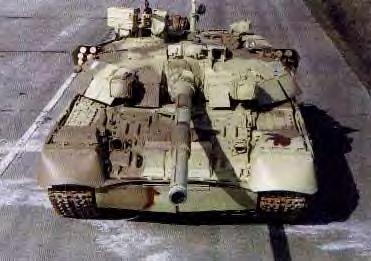
Hull and general design
Being a Ukrainian development of the Soviet-era T-80UD, the T-84 shares many design elements with older models. It retained the six-roadwheel layout, vertical propellant autoloading system, well sloped frontal glacis, and the low profile featured on every Soviet MBT. Other major design features include the welded turret, six-cylinder diesel engine, heavy usage of Kontakt-5 ERA, and a high power to weight ratio.The T-84’s hull is 7.09 meters (23 ft 3 in) in length and 3.78 meters (12 ft 4 in) in width, as with the T-80 and T-80UD. It retains the high LOS thickness glacis plate from those two vehicles, and most importantly, it is home to the autoloading system and accompanying carousel.
The T-84 is unique because it is equipped with the all new welded turret, which was originally tested on a few of the Object 478 variants. It offers better protection on the both the front and side of the turret, along with adding modularity in its’ armor. With this new turret, the total height of the vehicle is a short 2.215 (7ft3) meters.
Protection, active and passive
Much like the T-80U it can be traced back to, and other Soviet vehicles, the T-84 has a rather complex form of composite armor. The Glacis plate is >600 mm (1ft11) LOS thick, and uses a passive-sandwich of rubber, steel, and additional alloys to take incoming fire. This is somewhat different to the T-80U, which, like the T-72B, used polycarbonate plates in place of rubber. The ideology behind the armor is identical; use the rubber/polycarbonate to expand and contract the metal plates, therefore causing them to bulge, and induce stress upon the penetrating rod or jet. This passive armor (NxRA) should offer protection up to rounds in the same specification of the M829A1, excluding external ERA. Less is known about the turret, though it is rumored to use a similar form of armor. Based on LOS thickness, it should be able to take rounds like the M829A1 in all areas of the turret itself, with the frontal cheeks offering further amounts of armor.Powerplant and performances
Unique to the T-84, it uses the 1200 hp 6TD-2 diesel engine. This engine is special in that it is actually multi-fuel, and hence can run on kerosene or jet fuel in addition to diesel. The transmission connected to it has 7 forward gears and 5 reverse gears, and together they allow the T-84 to hit 70 kph.Armament
Like the T-80UD before it, the T-84 is equipped with the Ukrainian KBA-3 125 mm smoothbore, 48-caliber gun. It is roughly equivalent to the 2A46-M1, and can fire APFSDS, HE-FRAG, and HEAT shells, along with GLATGM’s. As with Russian equivalents, it can fire HE-FRAG shells out to 12 kilometers, GLATGM’s to 5 kilometers, and HEAT/APFSDS to 3 kilometers. There is a large variety of APFSDS ammunition the vehicle has access to, though the most numerous will naturally be the 3BM-42 ‘Mango’ and 3BM-32 ‘Vant’. Both rods are rated at ~450 mm of RHA penetration at the test distance of 2 kilometers.Information on what HEAT rounds are in the Ukrainian inventory is not available, though 70’s and 80’s designs penetrating 500-750 mm of RHA are the most likely to be found. The GLATGM used is the laser-guided Kombat, which is similar in design to the 9M119 Refleks. It is effective out to 5 kilometers and can penetrate up to 950 mm of RHA. As a whole the vehicle can hold 40 rounds, with 28 stored in the carousel ready for use. Additionally, there is a 12.7 mm machine gun for the Tank Commander and co-axial 7.62 machine gun as well.
Upgrades Prototypes
Further development of the T-84 was carried out on the protoypes 478DU4, 478DU5, 478DU7 and 478DU8 while 478DU3 and 478DU6 stayed paper projects. Object 478DU4 received an improved gearbox adapted to the new, more powerful engine, with a 7 forward, 3 reverse gearbox (one reverse on the T-80UD), significantly expanding flexibility. On a good road, the T-84 was able to reach 73 kph and up to 32 kph backwards, far better than the T-80UD. Later indexed 478DU5, it was also equipped with a 4 kW air conditioner (250 m3/h) to ensure better crew conditions and temperature stability for more sensitive instruments quite useful for desrt operations. This system was located in a special box mounted aft of the turret while the ammunition compartment was better isolated from the fighting compartment. This air conditioning was an argument by the Ukrainians well appreciated by the Pakistani, noting that according to the Indian magazine Political Events, about 80 thermal imagers on Russian T-90S failed during four years due to the absence air conditioning. Thus in case of war, the opposing Pakistani tanks would have a clear advantage in combat. See the prototype evolution:Object-478DU2
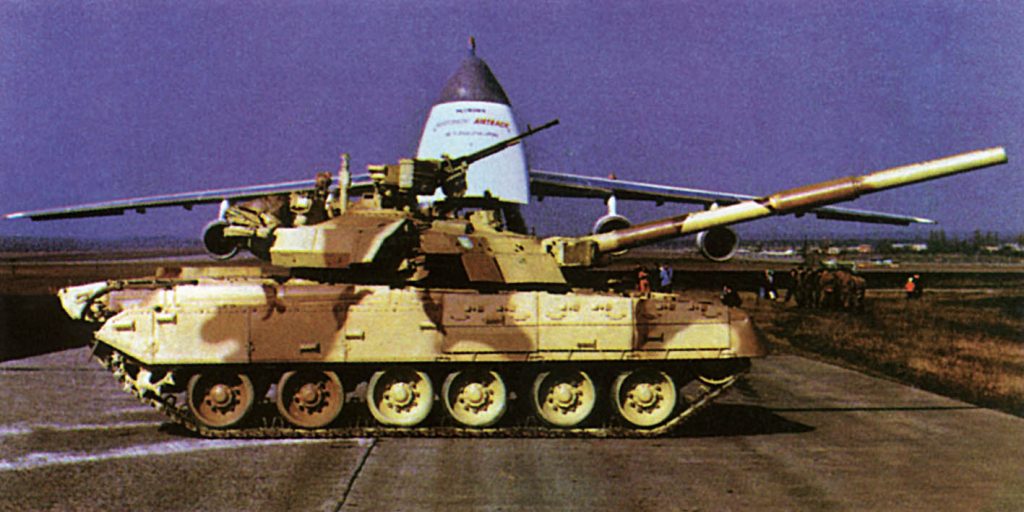
The Object-478DU2 name is given to early, mid-90's T-84 units that began to adopt indigenous manufactured components (such as the KB series of 125 mm smoothbore cannons). One of these vehicles was the first to be shown off publicly -at the IDEX-95 Arms Expedition.
Object-478DU4
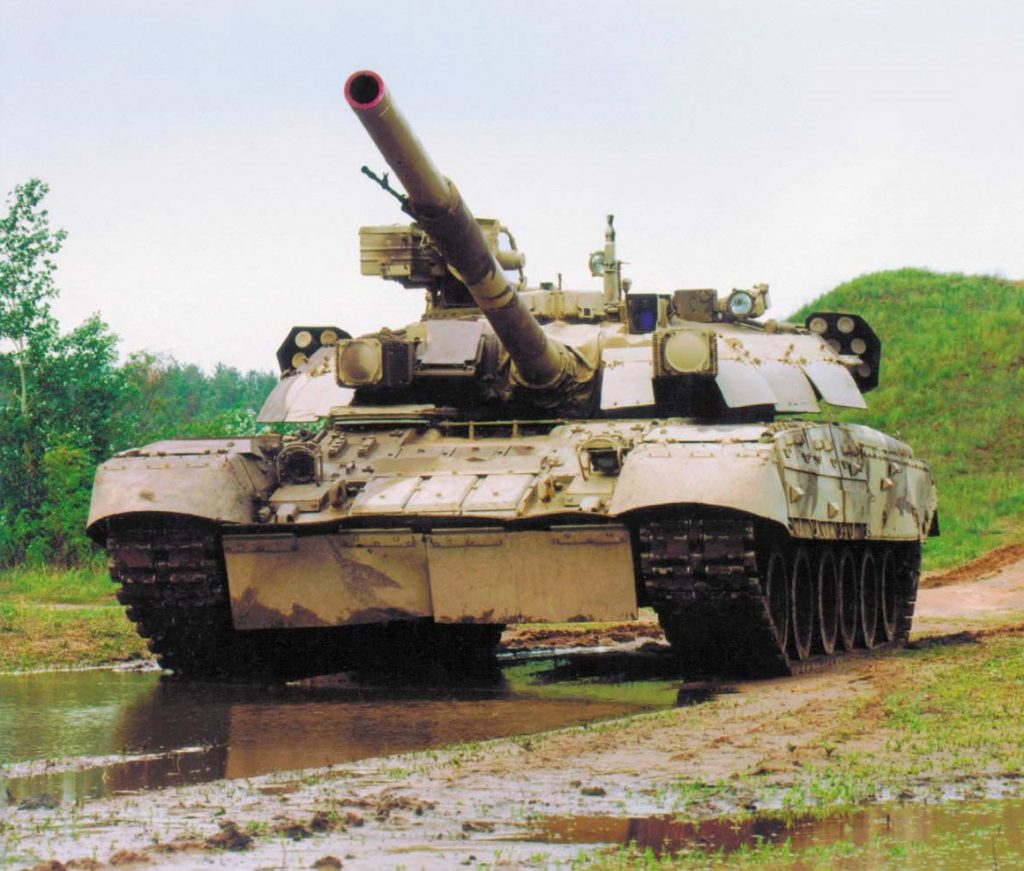
Evolving from its' former model, the Object-478DU4 received an upgraded transmission permitting speeds in excess of 70 kph forwards and 30 kph rearwards -three total reverse gears allowed for the latter feat.
Object-478DU5
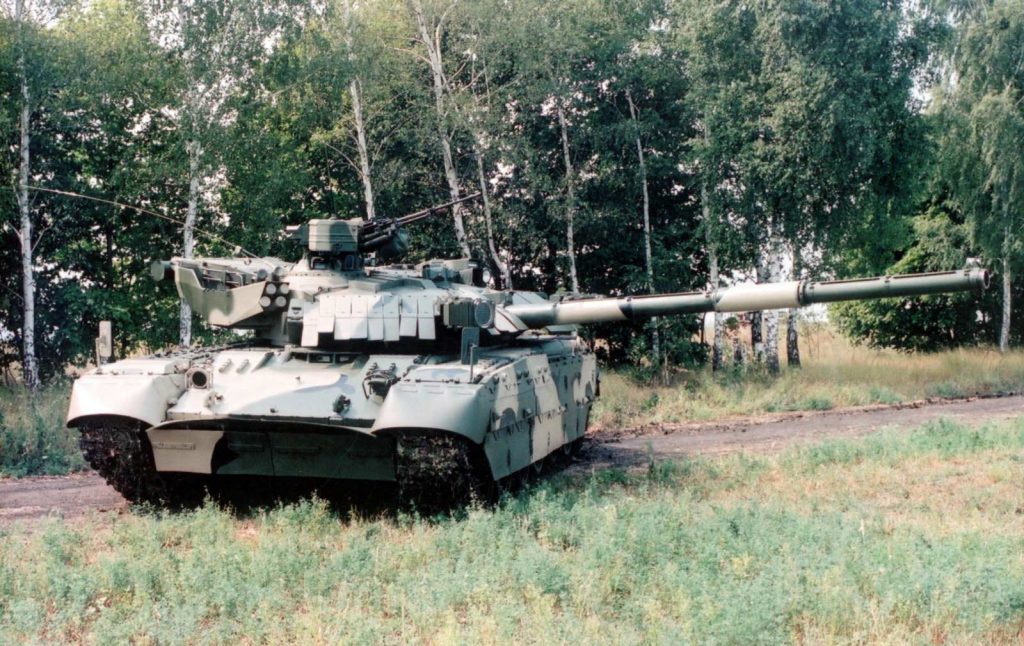
Compared to its' predecessors, the DU5 variant featured the most substantial upgrades overall. The manual transmission was replaced by an automatic Suat unit, ammunition storage was altered and isolated in the interest of crew safety, and an air conditioning system was added as well. This model went on to compete in Greece's 1998 tank trials.
The automatic transmission control system (SUAT) provided a better control at all operating modes with automatic gear shifting in order to save fuel and reduce driver's work. Levers were a souvernir left to the old days of Soviet vehicles. Instead came a special steering wheel. The system also automated the engine start mode and was accompanied by a new data display about current operating modes using various digital indicators on a modernized dashboard.
T84 Oplot

The T84 Oplot in short was the logical evolution of the T-84.
The Greek contest and Object-478DU9 (1998)
In 1998, the T-84, competed against the M1A2 Abrams, German Leopard 2A5, Russian T-80U, British Challenger 2E, and French Leclerc for the pre-tender trials in Greece which wanted to upgrade its fleet of M60s and Leopard 1s. The Leo 2 was retained and the T-84 lost. This brought a number of lessons. According to the results, numerous changes were made to the T-84, leding to the appearance an improved version, first indexed as 478DU9. This new variant 1999 in Abu Dhabi at IDEX-99 and in the west to simplify classification it was designated T-84U, but KMDB never used that denomination, at least officially. T-84 there showed its excellent driving performance.A new Protection: KDZ "Knife"
When designing 478DU9, greater attention was paid to improve crew satefy. The frontal part of the hull and turret were reinforced against direct ammunition hits instead of the active protection procured by "Kontact 5". This upgrade was developed by the Research Institute of Steel and led to a new standard called "KDZ" and later "Knife" with improved characteristics, and efficiency claimed to be increased up to 2.5 times compared to Kontakt 5. Work on KDZ "Knife" started already by 1997, when issues were noted by the Pakistani on their T-80UD Kontact 5 systems, notabl because they originated in Russia, at the Russian Research Institute of Steel which had an international patent for this protection system and forbade Malyshev to use it or pay an extra 55 million dollars so circa 10% of the contract value, that the Pakistani were understandably not willing to pay.So this forced the Ukrainians to came up with their own version, and achieved a better protection through increasing the area of side screens, continuing almost down to the wheel hubs, also to reduce thermal visibility using shielding thermal radiation from the hubs and rubber bands heating up on the move, up to 200°C. The screen also increase the area subjected to RPG impacts and also reduced dust formation while leading to a more optimal air flow.
Adoption of an APU
Another point was the lack of an auxiliary source of electricity, when the engine was cold, to have all systems ready for combat at all times without delays. This absence was regarded by the Pakistani still as a significant drawback the T-90s diud not have thanks to their mixed powerplant. Therefore, the EA-8A auxiliary power unit producing 8 kW was installed on the new 478DU9 prototype, providing energy for all tank systems while the engine was cold. A small diesel engine was tailored for this at KhKBD which mirrored the one on the T-80, as its GTA-18 gas turbine unit was installed as auxiliary. It weighted 300 kg and could operate for 24 hours, located at the rear of the right fender in a special armored box instead of a fuel tank.Other system upgrades
The 478DU9 received the new radio navigation system 1KRNA, using data from the GPS NAVSTAR satellite system or Russian GLONASS. Its location was determined with an accuracy of 20 m and it enabled data tranfer from it to the new ballistic computer 1V528-2, and significantly improve accuracy at long range. Conventional radio communication still was ensured by the R-163-50K station (50 km range).Also the 478DU9 the tank showed new ruberrized shoes using a polymer material, which was offered with removable shoes or non-removable ones. They helped considerably reducing vibrations while still being compatible with desert conditions. 478DU9 by Decree No. 237-5, February 8, 2000, was adopted by the Armed Forces of Ukraine under the name "Oplot". The state order for the T-84 in the turned out to be insignificant with just 10 produced, but the Malyshev plant and KMDB at least secured a massive order of a model close to it (The pakistani T-80UD) and was confident of the attractiveness of the T-84 on the export market. So even without domestic order, the T-84 was now ready to compete with any other country's own champion, and did not need the Ukrainian army purchase to ensire the company's profitability.
Evolution: The Object-478DU10 (BM Oplot)
In 1994, designer KMDB, and the Malyshev Factory, hit their mark with the T-84. It was a completely Ukrainian design, and gave their industry more freedom as a result. As a general improvement to the T-80UD it can be traced to, the T-84 included many upgrades, such as a new welded turret, 6TD-2 1200 hp engine, thermal imaging sight, auxiliary power unit, and a few additional upgrades to the fire control system. Excluding the upgrades, it also moved to many Ukrainian-made sights, sensors, and additional components."NATO oddball": The T84-120 Yatagan
The T-84-120 Yatagan was developed in 2000 in Kharkiv to NATO standards, just for the Turkish tender which eventually was cancelled as the Altay indigeneous MBT was developed from the Korean Black Panther. The tank featured a 120mm smoothbore gun compatibke both for the Russian AT-11 Sniper ATGM in Turkish inventory and with a reloading mechanism and blow-out panels. The "Yatagan" (a famous Ottoman saber) was also equipped with communications equipment from the Thomson and the Belgian FN Herstal light machine gun and on the roof a remotely-controlled Browning M2HB 0.5 cal. anti-aircraft machine gun. It also had a new automatic transmission but the same 6TD-2 diesel while also reusing the Ukarinian made fire control system of the Oplot. In total, three 120mm guns of different designs were tested. The T-84-120 Yatagan participated in the Kyiv parade despite not being in service with the Ukrainian forces.It failed at the contest, nor received any orders from other customers. However in the current context of the war in Ukraine as of 2023 it is a solid contender for production since Ukraine is backed by NATO's own industrial might. Europe decided indeed in May to radically increase ammunition production, and this includes those destined to standard 120 mm guns deployed by the Leopards. It is not impossible to see in the future even more western upgrades to the T-84-120 and see it resurface in 2024 (if the conflict is still not resolved) as this time Ukrainian's new main battle tank. It is also likely to become a basis for future developments in case of Ukraine joining NATO at a later date. But the current status of the prototype is unknown. It is known internally as the KERN2-120.
Oplot-M and Oplot-T

Oplot-M (Object 478DU9-1)
The Oplot-M Main Battle Tank (MBT) was revealed in 2008 as an improved version of the Oplot, keeping the old Russian "M" for modernization. Main components were developed back in the 1990s with additions made in the early 2000s and it completed Ukrainian Army trials but was not ordered by the Ukrainian Army for the same reasons as the T-84. The conflict today would change this situation. This was a reverse for KMDB largely compensated by the order by Thailand of 49 of these (see below). The Oplot-M MBT has the new Duplet (Nozh-2) built-in Explosive Reactive Armor (ERA) for tandem warheads, an evolution of the previous "Knife" and saif to be several fold superior to the Russian Kontakt 5. The sides received improved extra paneling over the ERA bricks combined with much lower flexible skirt panels. It is also fitted with the Shtora countermeasures system which nullify ATGMs using semi-automatic guidance. The Zaslon active protection system is now also an option.Armament side, no big change, with the same Ukrainian 125 mm fully-stabilized smoothbore gun fitted with a carousel-type autoloader. The amunition range is wide, with the 9K119M Reflex (NATO AT-11 Sniper-B) gun-launched ATGM capable of 5 km range, completed by the "usual suspects", HEASH, HE, HEAT and APFSDS rounds. A total of 40 rounds are carried. The same Oplot hunter-killer engagement capability also is built-in, enabling the Commander to use its panoramic sight including thermal vision to look up for target, completed by an emergency fire control. Laying of the gun is automatic, the gunner taking over and completing the process while the commander looks for new target. The turret has improved sights, with western tech. The Oplot-M is given a standard coaxial 7.62 mm light machine gun and RWS 12.7 mm machine gun on the roof. There is no loader thanks to the automatic ammunition loading system.

Performances wise, the new Oplot-M is powered by the 6TD-2E turbocharged diesel engine which transmission has 4 reverse speeds, an evolution of the 6TD-2 developing 1 200 hp, and said to be "more environmentally friendly" for its better automatic gearbox to imprve fuel consumption at all regimes. The 1,500 hp 6TD-3 is the next logical step, developed in Ukraine, but the current war probably delays its development. The Ukrainians claimed the Oplot-M is faster and better than the Russian T-90, T-90M and T-90MS Tagil. Like the previous Oplot, it has the same APU (auxiliary power unit) installed at the rear. It is also provided with a deep wading kit to ford up to 5m deep rivers.
Oplot-T (Object 478DU9-2)
The "BM Oplot-T" is an export version for Thailand with some minor modifications to meet local requirements: More powerful radio (to overcome forested area) clutter, better air conditioner and local small arms. 49 were on order initially when signed in 2013 for a delivered planned by 2014. However, the Russian invasion of the Donbass delayed this to a completion in 2018. It seems by 2016, 20 were delivered, by 2017, 36, and the remainder in 2018. It was assorted by a purchase of the BREM-T armored recovery vehicle revealed in 2013 and also specially developed to meet the Thai Army requirement based on the Oplot-M tank chassis and roughly identical to the Ukrainian Atlet ARV.Oplot-P tender (2017)

Some sources reported a possible Pakistan order for 294 Oplot-M tanks and 12 Atlet armored recovery vehicles scheduled for 2018-2021. It is reported tested in Pakistan 7along with the Chinese vt4 and Russian t90 by 2017. The war since 2014 raised concerns however (with the late deliveries for Thailand) of a rapid acquisition given the numbers involved and current state of the war in Ukraine. One option, which involves considerable investment from the Ukrainians in Pakistan, is the setting up of an assembly line, with components manufactured in Ukraine, before a licence production, as for the previous Al Khalid based on the MBT-2000. It seems Pakistan is quite happy with the engines and plan a local production for the 2020s, no date being specified. Visually the "Oplot-P" differs from the "M" by the new add on armor in front of Turret, side armor on hull and lack of Varta APS in second unit. If development of the 6TD3 diesel engine is finalized, there is chances for indeed an order. The electronics are likely to be a mix of French (Thomson) and Turkish (Aselsan) systems as well for the optics and FCS.

By November 2019 however it was announced that the Oplot-M failed to meet the requirements and retired, while the VT-4 cleared the second trials, still wouthout official announcement for its induction in the Pakistan Army. The press regularly also speaking of the "Al Khalid II" to be locally produced, perhaps with the VT-4 as a base. Norinco announced the bid "won" in 2019, but it was left unconfirmed. The final announcement was made in March 2023, Pakistan conforming the purchase of 679 VT-4 to be locally assembled.
Sub-Variants

BREM-84 Atlet: An armoured recovery vehicle based on the T-84 Oplot chassis. One produce so far as demonstrator.
BREM-T: Armoured recovery vehicle based on the T-84 Oplot-T chassis.
BMU-84: Armoured Vehicle Launched Bridge (AVLB).
TMP-84: Heavy infantry fighting vehicle prototype based on the T-84 Oplot: Lengthened hull, extra pair of road wheels, rear compartment housing five infantrymen.
In active service
The impact of the T-84 on the Ukrainian Armed forces has been low to say the least. Ukraine mosty counts on a fleet of modernized T-72s (Like the latest AMT upgrade) and T-80UDs. Only ten T-84 were manufactured but four being prototypes, this left six in actual serial standard, and from its adoption in 1999, it was of course rapidly brought to the frontline when the war started in 2014. At least one was spotted with the 14th Mechanized Brigade in Donbass and after the 2022 Russian invasion of Ukraine, at least one T-84U was deployed with the 3rd Tank Brigade also in Donbas near Barvinkove and Slovyansk. So far according to spioenkop none has been reported missing.Sources/Links
Oplot-M on military todayOn armor.kiev.ua
forcesdz.com on the Oplot T
Oplot on militaryfactory.com/
T84 MBT on armyrecognition.com
army-technology.com Oplot M
Pakistan choice of the VT-4 over the Oplot-P
The Oplot M exports on kh.depo.ua
About the Oplot-P on defence.pk
Ukrainian equipments
The yatagan on army-guide.com
Ukrainian equipment losses on spioenkop
militarytoday.com on the Yatagan
Model Kit
An article by Mike Ennamorato & David B, completely rewritten and expanded by David B. on 05-07/07/2023
T-84 specifications | |
| Dimensions | 7.086 x 3.775 x 2.215 m (23 ft 3 in x 12 ft 5 in x 7 ft 3 in) |
| Total weight, battle ready | 46 tonnes |
| Crew | 3: Pilot, Cdr, Gunner |
| Propulsion | KMDB 6TD-2 6-cyl diesel 16.3l 1,200 hp (890 kW) pw 26 hp/t |
| Suspension | Torsion bars, hydraulic dampers |
| Speed (road) | 65 km/h (40 mph) |
| Range | 1,300 L (290 imp gal; 340 US gal) for 540 km (340 mi) |
| Armament | 125 mm smoothbore KBA-3 cannon (43 rds) +13°, -6° 7.62 mm KT-7.62 coaxial machine gun 12.7 mm KT-12.7 anti-aircraft machine gun |
| Armor | Steel, composite, ERA |
| Total Production | c10, 5 active |
Gallery
Illustrations

Ukrainian T-80UD for Pakistan, the initiator

T-84 Oplot

T-84 Yatagan prototype

Object-478DU9 (Oplot-M prototype) in IDEX 1999 exhibition colors
Photos
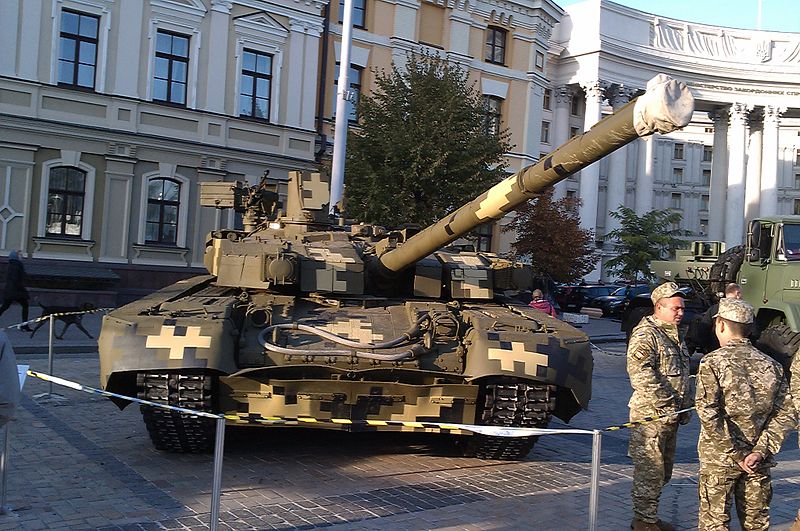
T-84 Oplot in Kiev.
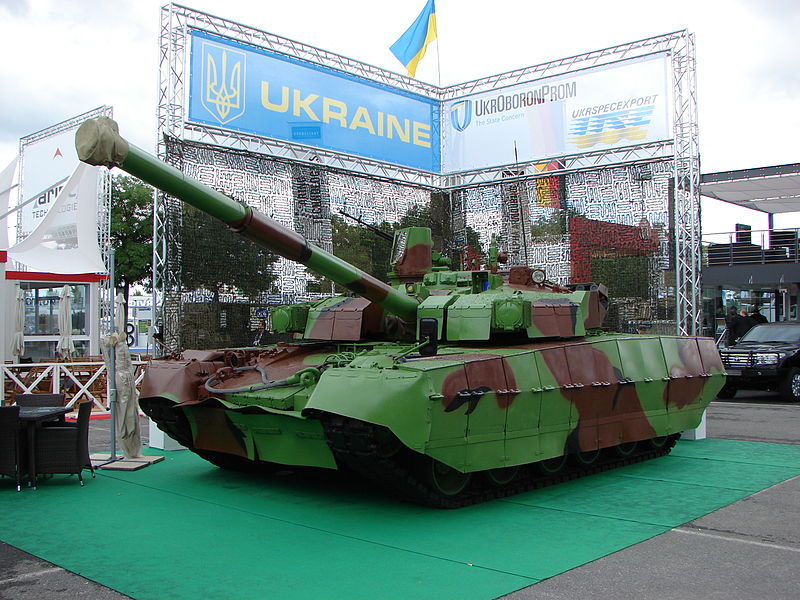
T-84 Oplot at Eurosatory
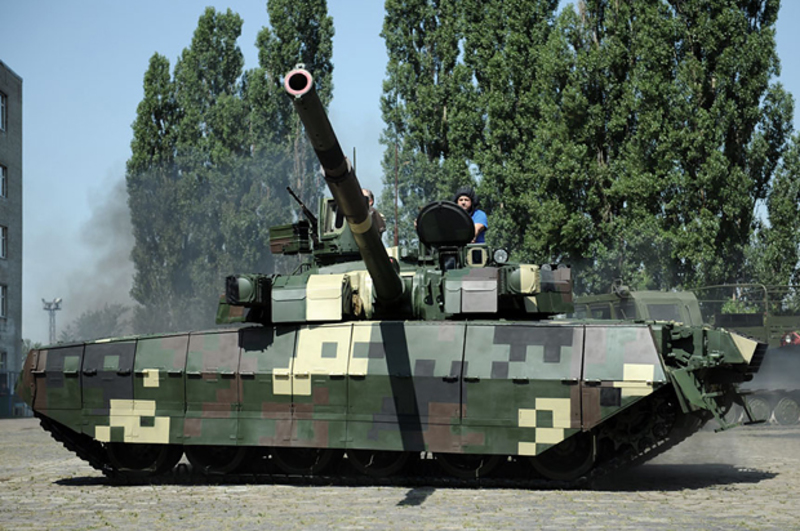
BM Oplot T demonstrator of the Thai Royal Army
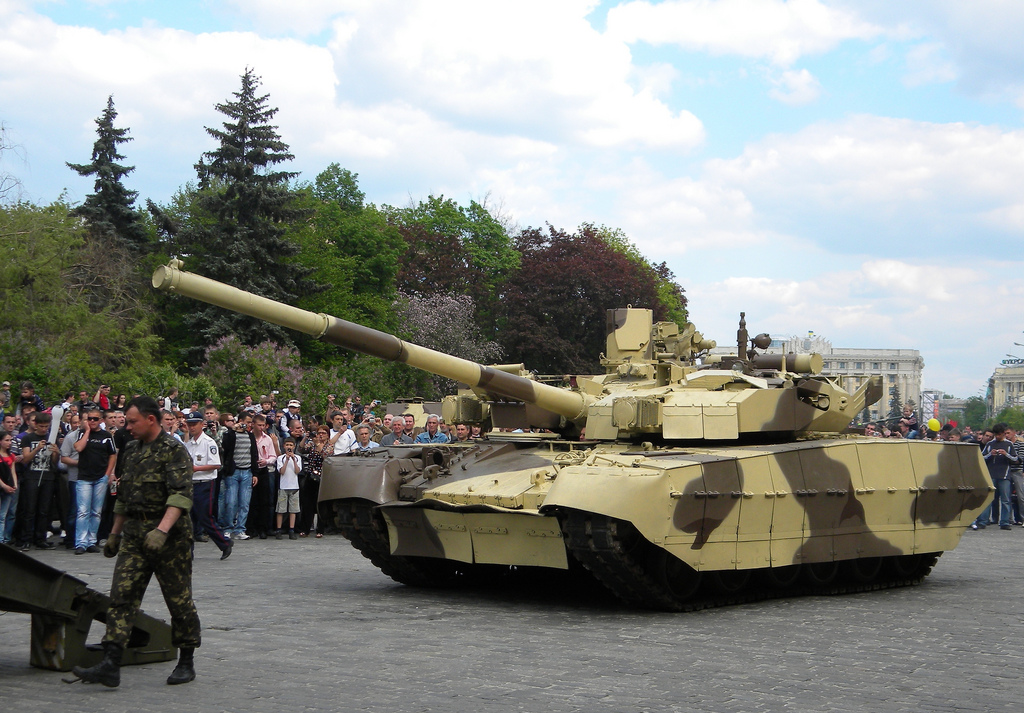
T-84 Oplot sent at IDEX Abu Dhabi back in Kiev, from the tank transporter

T-84 Oplot M in field tests

Rear view of the Oplot, without side skirt

Oplot M demonstrator

Oplot T demonstrator at KMDB

T-84 Oplot M with a ...rather flashy camouflage, the one shown at Satory

Early demonstrator Oplot T

T-84 Oplot P in Pakistan, 2017, for comparative trials with the VT-5

T84 Oplot T before delivery to Thailand

T-84 Oplot T today, operated without the side skirts

Same, other view
Same, in manoeuvers. Via reddit tank porn.
Videos

Modern Tanks
Modern MBTs posters

Denel Bagder (2018)

Type 16 MCV (2016)

Gepard 1A2 last rounds 2011

SANDF

Russian AFVs

Main Battle Tanks
